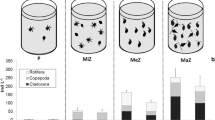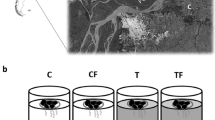Abstract
One of the most obvious features of tropical lakes and reservoirs is the small body size of their zooplankton taxa. It is believed that this is the result of high and persistent predation by abundant planktivorous fish, which select large-bodied zooplankton prey thus making them more vulnerable to extinction in tropical as compared to temperate habitats. Do these extinctions result directly from fish predation? Could the high predation-induced mortality alone be responsible for an extermination of the population from a habitat? Or could indirect effects of predation be responsible? Some important indirect effects can be seen at the demographic level; these include reduced reproduction in the population resulting from higher vulnerability of ovigerous females to predation by visually oriented planktivores. Other important indirect effects can be observed at the individual level; these include shifts in behavior (from foraging to predator avoidance) and adjustments in physiology (from high to low feeding rate) in those planktonic animals which detect danger from their predators by sensing either the ‘predator odor’ or an ‘alarm substance’ originating from injured conspecific prey. Although a zooplankton species density may mostly result from the brutal force of direct predator impact on the population (mortality), it is more likely that its distribution in time and space could be attributed to a combination of indirect effects of predation on individual behavior and physiology. An example of periodicity in density and depth distribution patterns of Cahora Bassa zooplankton species and their periodic exterminations seems to confirm the role of indirect effects of predation by planktivorous fish.
Similar content being viewed by others
References
Bollens, S. M. & D. E. Stearns 1992. Predator-induced changes in the diel feeding cycle of a planktonic copepod. J. exp. mar. Biol. Ecol. 156: 179–186.
Brooks, J. L. & S. I. Dodson, 1965. Predation, body size and composition of plankton. Science 150: 28–35.
Dawidowicz, P., 1993. Which components of predator avoidance behaviour in zooplankton are most costly? Verh. int. Ver. Limnol. 25 (in press).
Dawidowicz, P. & Z. M. Gliwicz, 1983. Food of brook char in extreme oligotrophic conditions. Envir. Biol. Fishes: 52–60.
Dawidowicz, P. & C. J. Loose, 1992. Metabolic costs during predator-induced diel vertical migration of Daphnia. Limnol. Oceanogr. (in press).
Dumont, H. J., 1980. Zooplankton and the science of biogeography: the example of Africa. In W. C. Kerfoot (ed.), Evolution and ecology of zooplankton communities. University Press of New England, Hanover, New Hampshire: 685–696.
Fernando, C. H., 1980. The species and size composition of tropical zooplankton with special reference to the Oriental Region (Southeast Asia). Int. Revue ges. Hydrobiol. 65: 411–426.
Folt, C. L., 1987. An experimental analysis of costs and benefits of zooplankton aggregation. In W. C. Kerfoot & A. Sih (eds), Predation, direct and indirect impact on aquatic communities. University Press of New England, Hanover, New Hampshire: 300–314.
Fryer, G., 1968. Evolution and adaptive radiation in the Chydoridae (Crustacea: Cladocera); A study in comparative functional morphology and ecology. Phil. Trans. r. Soc. London B, 254: 221–385.
Gliwicz, Z. M., 1967. Zooplankton and temperature-oxygen conditions of two alpine lakes of the Tatra Mountains. Pol. Arch. Hydrobiol. 14: 53–72.
Gliwicz, Z. M., 1984. Limnological study of Cahora Bassa reservoir with special regard to sardine fishery expansion. FAO UN, Rome, 71 pp.
Gliwicz, Z. M., 1985. Predation or food limitation: an ultimate reason for extinction of planktonic cladoceran species. Arch. Hydrobiol. Beih. Ergebn. Limnol. 21: 419–430.
Gliwicz, Z. M., 1986. A lunar cycle in zooplankton. Ecology 67: 885–897.
Gliwicz, Z. M., A. Ghilarov & J. Pijanowska, 1981. Food and predation as major factors limiting two natural populations of Daphnia cucullata Sars. Hydrobiologia 80: 205–218.
Gliwicz, Z. M. & W. Lampert, 1993. Body-size related survival of cladocerans in atrophic gradient: an enclosure study. Arch. Hydrobiol. 127 (in press).
Gliwicz, Z. M. & J. Pijanowska, 1988. Effect of predation and resource depth distribution on vertical migration of zooplankton. Bulletin of Marine Science 43: 695–709.
Gliwicz, Z. M. & J. Pijanowska, 1989. The role of predation in zooplankton succession. In U. Sommer (ed.), Plankton ecology: Succession in plankton communities, Springer, Heidelberg: 253–296.
Gliwicz, Z. M. & M. G. Rowan, 1984. Survival of Cyclops abyssorum tatricus (Copeposda, Crustacea) in alpine lakes stocked with planktivorous fish. Limnol. Oceanogr. 29: 1290–1299.
Green, J., 1967. The distribution and variation of Daphnia lumholzi (Crustacea, Cladocera) in relation to fish predation in Lake Albert, East Africa. J. Zool 151: 181–197.
Hairston, N. G. Jr., 1987. Diapause as a predator avoidance adaptation. In W. C. Kerfoot & A. Sih (eds), Predation, direct and indirect impact on aquatic communities. University Press of New England, Hanover, New Hampshire: 287–290.
Hall, D. J., S. T. Threlkeld, C. W. Burns & P. H. Crowley, 1976. The size-efficiency hypothesis and the size structure of zooplankton communities. Ann. Rev. Ecol. Systemat. 7: 177–208.
Havel, J. E., 1987. Predator-induced defenses: a review. In W. C. Kerfoot & A. Sih (eds), Predation, direct and indirect impact on aquatic communities. University Press of New England, Hanover, New Hampshire: 263–278.
Hrbacek, J., M. Dvorakova, V. Korinek & L. Prohazkova, 1961. Demonstration of the effect of the fish stock on the species composition of zooplankton and the intensity of metabolism of the whole plankton association. Verb. int. Ver. Limnol. 14: 192–195.
Jacobsen, P. J. & G. H. Johnsen, 1988. The influence of food limitation on swarming behaviour of the waterflea Bosmina longispina. Anim. Behav. 36: 991–995.
Kalinowska, A. & J. Pijanowska, 1987. How not to be eaten? Plant, prey and host on the defensive. Wiadomosci Ekologiczne 33: 3–20 (in Polish, English Summary).
Kerfoot, W. C., 1975. The divergence of adjacent populations. Ecology 56: 1298–1313.
Kerfoot, W. C. & M. Lynch, 1987. Branchiopod communities: associations with planktivorous fish in space and time. In W. C. Kerfoot & A. Sih (eds), Predation, direct and indirect impact on aquatic communities. University Press of New England, Hanover, New Hampshire: 367–378.
Lampert, W., 1989. The adaptive significance of diel vertical migration of zooplankton. Funct. Ecol. 3: 21–27.
Lampert, W., 1993. Phenotypic plasticity of the size at first reproduction in Daphnia: the importance of maternal size. Ecology (in press).
Lazzaro, X., 1987. A review of planktivorous fishes: Their evolution, feeding behaviors, selectivities and impacts. Hydrobiologia 146: 97–167.
Li, J. L. & H. W. Li, 1979. Species-specific factors affecting predator-prey interactions of the copepod Acathocyclops vernalis with its natural prey. Limnol. Oceanogr. 24: 613–626.
Machacek, J., 1991. Indirect effect of planktivorous fish on the growth and reproduction of Daphnia galeata. Hydrobiologia 225: 193–197.
Mellors, W. K., 1975. Selective predation on ephippial Daphnia and the resistance of ephippial eggs to digestion. Ecology 56: 974–980.
Miller, T. E. & W. C. Kerfoot, 1987. Redefining indirect effects. In W. C. Kerfoot & A. Sih (eds), Predation, direct and indirect impact on aquatic communities. University Press of New England, Hanover, New Hampshire: 33–37.
Pijanowska, J., 1993. Diel vertical migration in zooplankton: fixed or inducible behavior? Arch. Hydrobiol. Beih. Ergebn. Limnol. 39 (in press).
Rhoades, D. F., 1979. Evolution of plant chemical defense against herbivores. In G. A. Rosenthal & D. H. Jansen (eds), Herbivores: their interaction with secondary plant metabolites, Academic Press, New York: 3–54.
Sib, A., 1980. Optimal behavior: Can foragers balance two conflicting demands? Science 210: 1041–1043.
Sib, A., 1987. Predators and prey lifestyles: an evolutionary and ecological overview. In W. C. Kerfoot & A. Sih (eds), Predation. Direct and indirect impacts on aquatic communities. University Press of New England, Hanover & London: 203–224.
Stibor, H., 1992. Predator induced life-history shifts in a freshwater cladoceran. Oecologia 92: 162–165.
Tucker, R. P. & S. P. Woolpy, 1984. The effect of parthenogenic eggs in Daphnia magna on prey location by the bluegill sunfish (Lepomis macrochirus). Hydrobiologia 109: 215–217.
Vanni, M. J., 1987. Effects of food availability and fish predation on a zooplankton community. Ecol. Monogr. 57: 61–88.
Visser, M., 1981. Prediction of switching and counterswitching based on optimal foraging. Z. Tierpsychol. 55: 129–138.
Visser, M., 1982. Prey selection by the three-spined stickleback (Gasterosteus aculeatus L.). Oecologia 55: 395–402.
Vuorinnen I., M. Rajasilta & J. Salo, 1983. Selective predation and habitat shift in a copepod species — support for the predation hypothesis. Occologia 59: 62–64.
Zaret, T. M., 1972. Predator-prey interaction in a tropical lacustrine ecosystem. Ecology 53: 234–257.
Author information
Authors and Affiliations
Rights and permissions
About this article
Cite this article
Gliwicz, Z.M. Relative significance of direct and indirect effects of predation by planktivorous fish on zooplankton. Hydrobiologia 272, 201–210 (1994). https://doi.org/10.1007/BF00006521
Issue Date:
DOI: https://doi.org/10.1007/BF00006521




